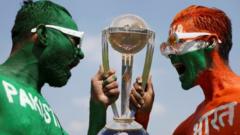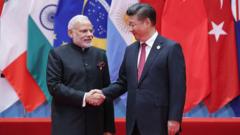The fervor surrounding the India-Pakistan cricket competition remains a testament to its history, culture, and the geopolitical backdrop, raising questions about its current relevance and appeal.
**Is the India-Pakistan Cricket Rivalry Still the Ultimate Showdown?**

**Is the India-Pakistan Cricket Rivalry Still the Ultimate Showdown?**
Exploring the enduring yet evolving dynamics of cricket's most iconic rivalry.
In the sporting world, few rivalries can match the intensity and passion of India versus Pakistan in cricket. With colorful stadiums and fans fiercely supporting their teams, this clash has been dubbed “the greatest rivalry.” Recently highlighted in Netflix's documentary, "The Greatest Rivalry: India v Pakistan," the historic backdrop of this competition is underscored by cricket legends like Virender Sehwag and Waqar Younis, who affirm its significance.
The documentary encapsulates the moments that define this rivalry, with narratives steeped in political history, suggesting that the competition extends beyond just the cricket field. Yet, recent performances raise questions about its current status. After Pakistan's crushing defeat to India at the Champions Trophy, skepticism looms about whether the rivalry has lost its competitive bite, with Pakistan winning only one of their last eight encounters.
Prominent Pakistani media outlets express dissatisfaction, questioning the rivalry’s intensity after consecutive losses. Editorials lament the lack of fierce competition, with some commentators attributing the rivalry's survival to political tensions rather than compelling performances on the field. For instance, writer Zohaib Ahmed Majeed argues that without wars of words or actual conflicts, the sporting rivalry pales, revealing the cricketers' lack of prowess.
Amidst these critiques, Pakistan's cricketing struggles expose deeper issues. Declining team performance combined with the historical challenges of isolation, instability, and a lack of representation in major leagues like the IPL leave them lagging behind their Indian counterparts.
Conversely, India's cricketing landscape flourishes, fueled by a potent domestic infrastructure and the wealth generated from the IPL, leading to a noticeable gap between the two teams. Pakistani cricketers feel increasingly marginalized and excluded from this lucrative world. The support networks that once boosted Pakistan cricket are dwindling, posing a long-term threat to their competitive spirit.
Despite historical disparities and a shift in game dynamics, the hype surrounding the rivalry remains prevalent. Viewership for these matches continues to soar, evidenced by over 600 million tuning in recently. Strong ticket sales point to a fanbase eager for the clash, with no shortage of excitement. Shubman Gill, India's vice-captain, maintains that the rivalry continues to capture fans' imaginations, fueling enthusiasm for every face-off.
Brand consultant Santosh Desai suggests that the narrative of rivalry thrives primarily in imagination, with India’s dominance fostering a storyline that builds anticipation, even when the actual competition seems to falter. The enduring financial impact and marketing value of this historic rivalry ensure that it continues to be a key attraction in the cricketing world—irrespective of the on-field results.
As the debate continues, one fact remains: the enduring nature of the India-Pakistan cricket rivalry, shaped by historical artifacts and cultural passion, transcends the mere scoreline, ensuring its status in the hearts of millions.
The documentary encapsulates the moments that define this rivalry, with narratives steeped in political history, suggesting that the competition extends beyond just the cricket field. Yet, recent performances raise questions about its current status. After Pakistan's crushing defeat to India at the Champions Trophy, skepticism looms about whether the rivalry has lost its competitive bite, with Pakistan winning only one of their last eight encounters.
Prominent Pakistani media outlets express dissatisfaction, questioning the rivalry’s intensity after consecutive losses. Editorials lament the lack of fierce competition, with some commentators attributing the rivalry's survival to political tensions rather than compelling performances on the field. For instance, writer Zohaib Ahmed Majeed argues that without wars of words or actual conflicts, the sporting rivalry pales, revealing the cricketers' lack of prowess.
Amidst these critiques, Pakistan's cricketing struggles expose deeper issues. Declining team performance combined with the historical challenges of isolation, instability, and a lack of representation in major leagues like the IPL leave them lagging behind their Indian counterparts.
Conversely, India's cricketing landscape flourishes, fueled by a potent domestic infrastructure and the wealth generated from the IPL, leading to a noticeable gap between the two teams. Pakistani cricketers feel increasingly marginalized and excluded from this lucrative world. The support networks that once boosted Pakistan cricket are dwindling, posing a long-term threat to their competitive spirit.
Despite historical disparities and a shift in game dynamics, the hype surrounding the rivalry remains prevalent. Viewership for these matches continues to soar, evidenced by over 600 million tuning in recently. Strong ticket sales point to a fanbase eager for the clash, with no shortage of excitement. Shubman Gill, India's vice-captain, maintains that the rivalry continues to capture fans' imaginations, fueling enthusiasm for every face-off.
Brand consultant Santosh Desai suggests that the narrative of rivalry thrives primarily in imagination, with India’s dominance fostering a storyline that builds anticipation, even when the actual competition seems to falter. The enduring financial impact and marketing value of this historic rivalry ensure that it continues to be a key attraction in the cricketing world—irrespective of the on-field results.
As the debate continues, one fact remains: the enduring nature of the India-Pakistan cricket rivalry, shaped by historical artifacts and cultural passion, transcends the mere scoreline, ensuring its status in the hearts of millions.



















